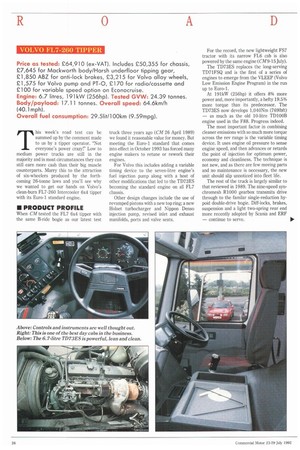T his week's road test can be summed up by the
Page 28

If you've noticed an error in this article please click here to report it so we can fix it.
comment made to us by a tipper operator. Not everyone's power crazy!" Low to medium power trucks are still in the majority and in most circumstances they can still earn more cash than their big muscle counterparts. Marry this to the attraction of six-wheelers produced by the forthcoming 26-tonne laws and you'll see why we wanted to get our hands on Volvo's clean-burn FL7-260 Intercooler 6x4 tipper with its Euro-I standard engine.
When CM tested the FL7 6x4 tipper with the same B-ride bogie as our latest test truck three years ago (CM 26 April 1989) we found it reasonable value for money. But meeting the Euro-1 standard that comes into effect in October 1993 has forced many engine makers to retune or rework their engines.
For Volvo this includes adding a variable timing device to the seven-litre engine's fuel injection pump along with a host of other modifications that led to the TD73ES becoming the standard engine on all FL7 chassis.
Other design changes include the use of revamped pistons with a new top ring; a new Holset turbocharger and Nippon Denso injection pump, revised inlet and exhaust manifolds, ports and valve seats. For the record, the new lightweight FS7 tractor with its narrow FL6 cab is also powered by the same engine (CM9-15July).
The TD73ES replaces the long-serving TD71FSQ and is the first of a series of engines to emerge from the VLEEP (Volvo Low Emission Engine Program) in the run up to Euro-1.
At 191kW (256hp) it offers 8% more power and, more importantly, a hefty 19.5% more torque than its predecessor. The TD73ES now develops 1,040Nm (7691bft) — as much as the old 10-litre TD100B engine used in the F88. Progress indeed.
The most important factor in combining cleaner emissions with so much more torque across the rev range is the variable timing device. It uses engine oil pressure to sense engine speed, and then advances or retards the point of injection for optimum power, economy and cleanliness. The technique is not new, and as there are few moving parts and no maintenance is necessary, the new unit should slip unnoticed into fleet life.
The rest of the truck is largely similar to that reviewed in 1989. The nine-speed synchromesh R1000 gearbox transmits drive through to the familar single-reduction hypoid double-drive bogie. Diff-locks, brakes, suspension and a light two-spring rear end more recently adopted by Scania and ERF — continue to serve.
















































































